
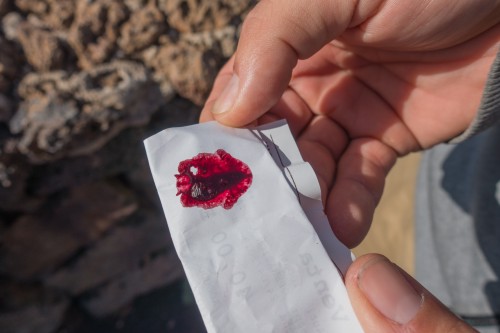
Today’s tour, with Eros, was set to depart at 9:00 instead of the 8:30 we’d had the previous several days, but we weren’t too worried about it since we were not leaving for Fuerteventura until 23:00. But we still got off the ship at 8:30, just in case there were any issues finding the meeting spot. There were buses out front for the ship’s tours, and we ran into Claudio. He asked us “let me guess, you’re on a private tour going all over the island?” We said yes, and he then asked “are you going on a camel ride?” To this we said no, we weren’t familiar. He said we needed to do this, as it is one of “the” things to do on Lanzarote. We decided we should do that, so long as it didn’t take away from other stuff we wanted to do.
We walked outside the secure area where there were a handful of taxis and other cars, but no Eros. But we got a text from him stating he was on his way. We told him we were outside the secure area. But in a couple minutes, when he said he’d arrived, but we didn’t see anyone new in the parking lot, we told him we thought maybe we were in different spots. It turns out the ship was docked in a different part of the port than what he thought, so he had to drive over from one terminal to the other. We finally connected just after 9. As with Guillermo and Paolo, we went over the stuff we wanted to see, plus timing issues. We decided not to visit Cueva de los Verdes since we’d already been in the lava tube on Tenerife, and this would save us a lot of time. He suggested we see the Cesar Manrique Cactus Garden instead, and we agreed since we hadn’t seen anything similar so far this trip.
 |
 |
We started by heading up the east coast from Arrecife to the Punta Mujeres area. Eros told us that one of the reasons the tour started at 9 was because on Lanzarote, most of the sites do not open until 10. When we got to the Cactus Garden, it wasn’t open yet. So he showed us Coccinella and its bright red natural dye. Coccinella is a bug that grows on Opuntia cacti, and when it is crushed it is super red. Eros showed us a quick demonstration, and sure enough, it was bright red. So Opuntia cacti (which are from Mexico) are farmed all over Lanzarote to harvest the bugs for making red dye.
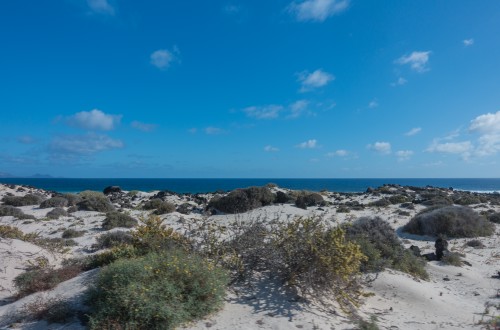 |
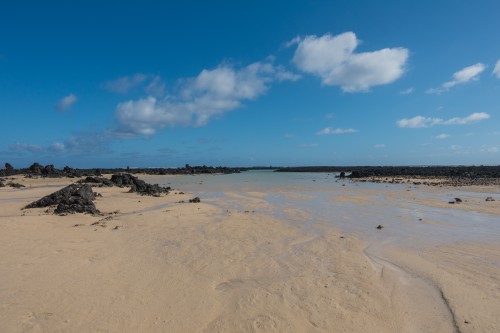 |
Rather than simply wait for 10am, Eros drove us up to ocean pool area almost to Orzola on the northeast coast. The ground was almost completely flat, and so as the tide came in, it came in quickly. From where we were we could see the town of Pedro Barba on La Graciosa (the more reddish part on the right of this picture), a nearby island just north of Lanzarote. One of the main sites on Lanzarote is Mirador del Rio, and we learned why it is called that. The ocean between Lanzarote and La Graciosa is basically completely calm, and very narrow, so effectively a river. Eros said some great diving is there, since it is clear and little if any swells. Eros also told us that La Graciosa is now its own administrative unit within the Canary Islands, so there are 8 islands – another commonality with Hawaii.
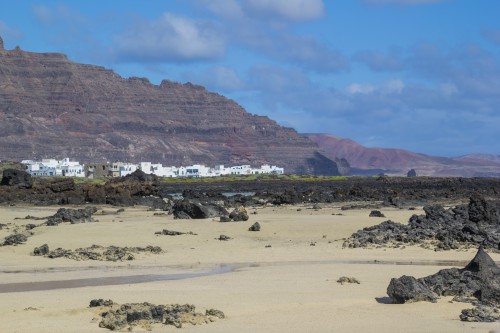 |
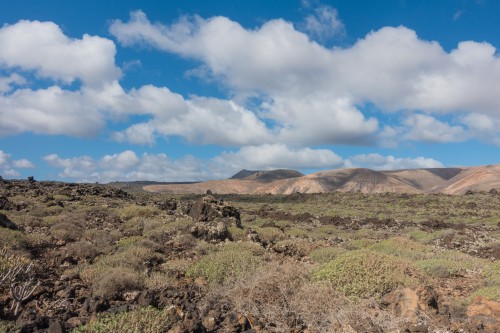 |
 |
The coast here had a lot of black lava rocks, flat ground, and almost no plants – a beautiful desolation. It reminded us a bit of the Waikaloa area on the Big Island. Perhaps because of that, we shouldn’t have been surprised to see a bunch of runners and bicyclists around. Eros mentioned that people were training for an Ironman triathlon that was coming up. He said it was the biggest/most prestigious outside of the one on the Big Island of Hawaii. The scenery looked very similar for both; we hoped for the runners’ sake it would be a little bit cooler and less humid here.
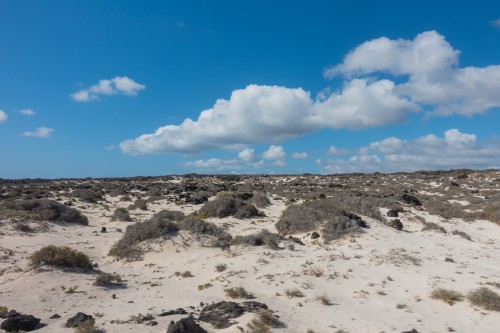 |
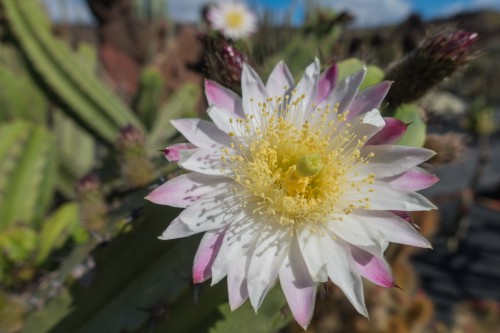 |
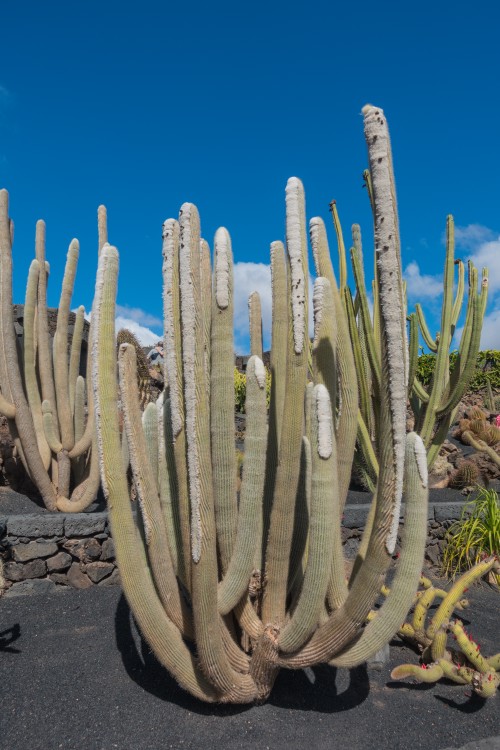 |
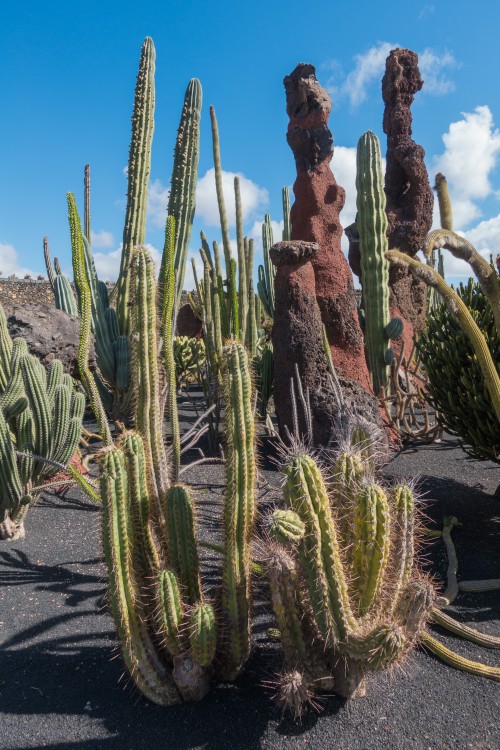 |
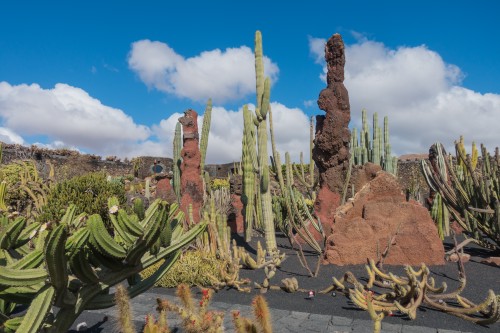 |
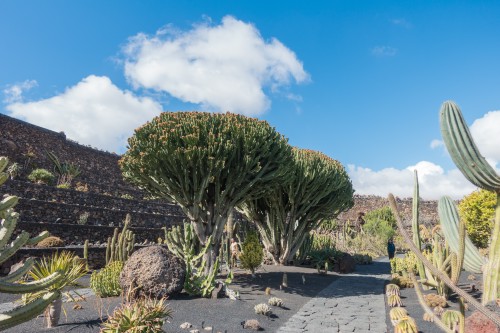 |
We headed back to the Cactus Garden, got there around 10:15, and it was already full with lots of people. The garden was designed by Cesar Manrique, a local artist who gained fame around 50 years ago. He did stuff all over the Canary Islands, but Lanzarote was where most of his work occurred, even on mundane subjects such as the middle of traffic circles. Also, it was at his request/urging that nearly all of the buildings on Lanzarote are short, white, buildings, so as to not detract from or overwhelm the natural beauty. This Cactus Garden was built in a bowl shape, and because of this the cacti inside can get much taller than they would outside, where eventually the wind would break off the tops. There were hundreds of really incredible cacti from all over the world, some of which we recognized from Southern California/Mexico, and some of which we recognized from Madagascar, but a ton we didn’t recognize at all. And the garden layout itself may have been more impressive. Like most of Cesar Manrique’s stuff, the building was not conspicuous from outside, but with lots going on inside. Near one of the restaurants there was an interesting light feature that looked like a bunch of bubbles hanging together, and a windmill was being used as a mill to process gofio, a local mix of cereals since flour does not perform particularly well and there needs to be a bread substitute.
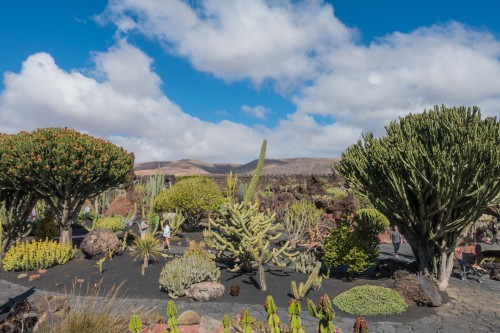 |
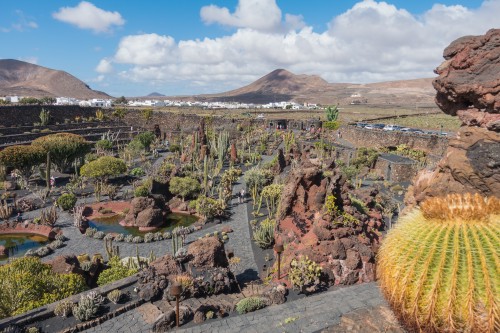 |
 |
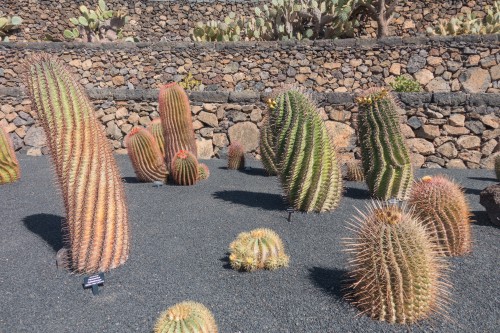 |
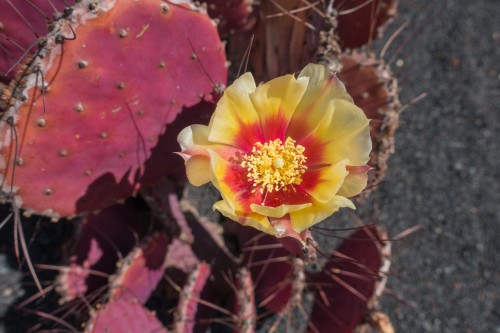 |
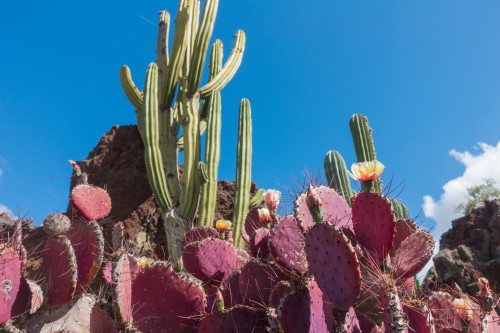 |
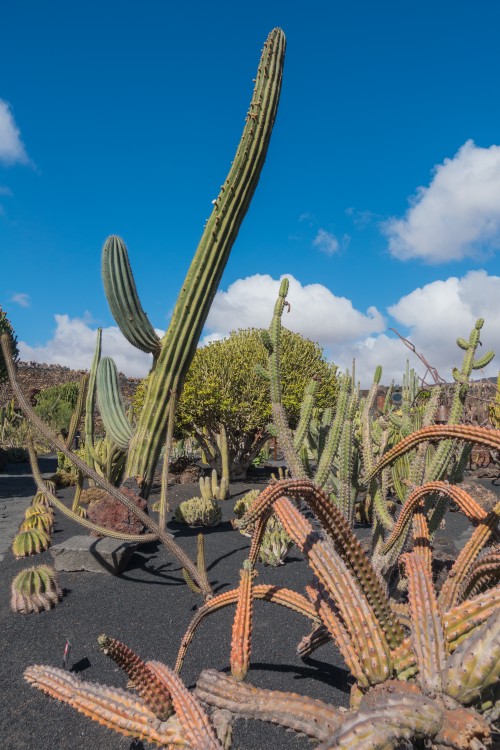 |
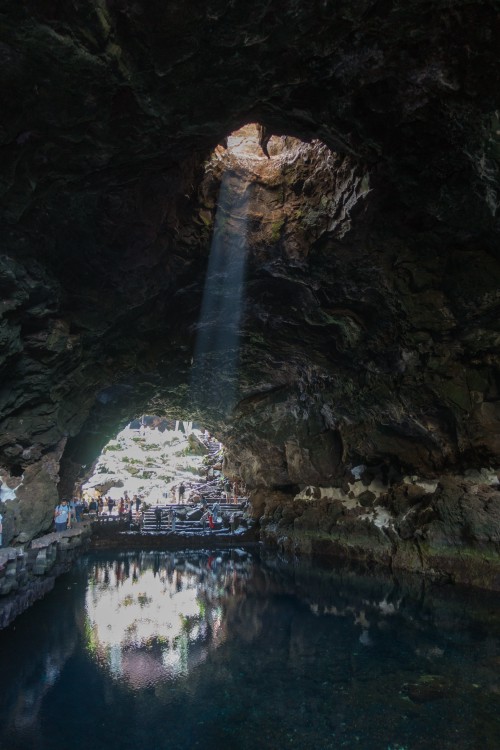 |
We next headed to Jameos del Agua, which Guillermo had strongly recommended yesterday. There were tons of cars and buses in the parking lot, so we were a bit worried the place would be a madhouse. As we were waiting to get the tickets, there was a sign stating a couple of the things would be closed, either because of renovation or because of outside events on the property. We hoped that wouldn’t limit our enjoyment. Once finally inside, there was a big cave with pool in middle. This is part of the lava tube, Cueva de los Verdes, that is just uphill from Jameos del Agua. Here there are a couple skylights and part of the tube filled with water. Eros pointed out these tiny white crab-looking things that live in the water. From the pool we headed up a bit to this area with a gorgeous white pool with turquoise water and lots of Canary Island Date Palms. There was even one Canary Island Date Palm that was growing on what effectively was a platform, suspended above the ground. We have no idea how the roots could support a tree that large with no soil.
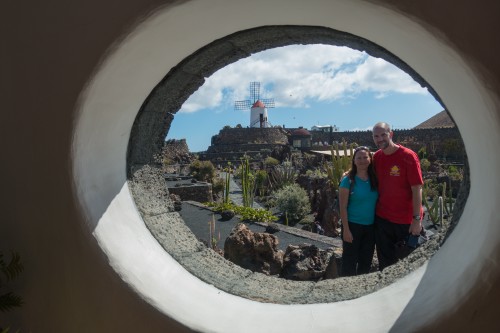 |
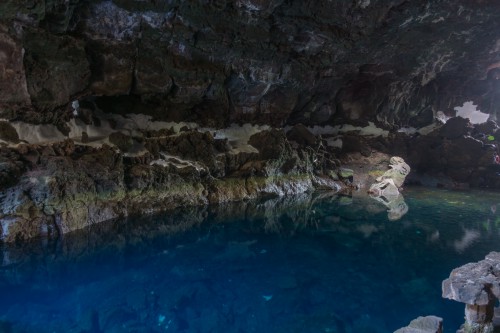 |
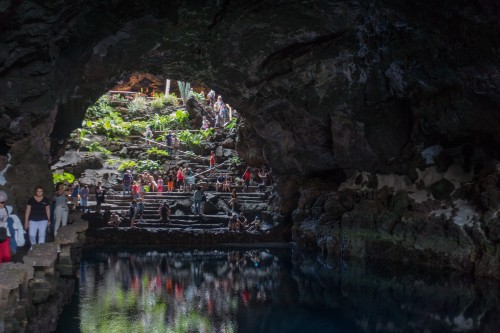 |
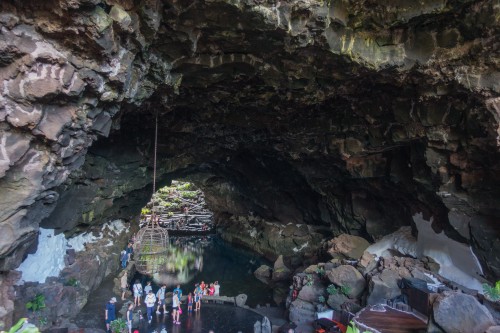 |
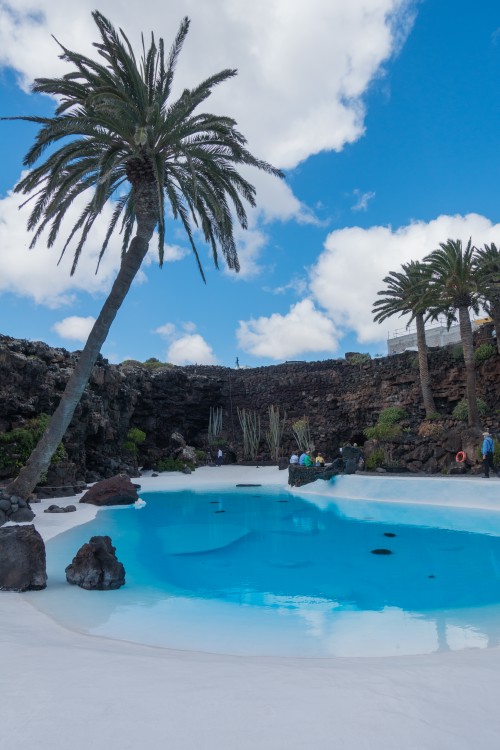 |
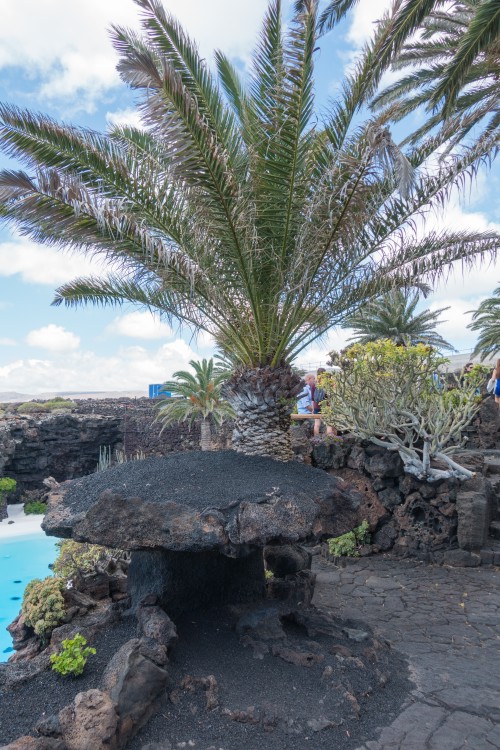 |
There were too many people, however, for our liking. Eros tried to take us into the amphitheatre area, but apparently he hadn’t seen the sign that it was closed for some private event. When he realized this, he said “That’s a bit disappointing.” Indeed. Justin had been thinking this all morning, but holding it in. Between a bunch of minor stuff, he was sort of irked, trying not to be since it was all fairly minor, but he had really high hopes for Lanzarote and it was (so far) paling in comparison to the other islands. Then again, the other islands had been magnificent, so that’s a high bar. After leaving Jameos del Agua, we headed up the road through a’a, past Cueva de los Verdes, towards Mirador del Rio. The road was purposefully narrow so as to disturb minimal lava and give off the best vibe of driving through a lava field, which we definitely got.
 |
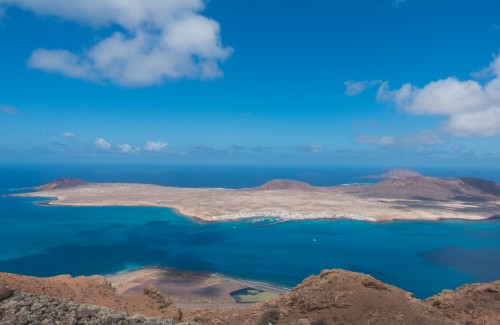 |
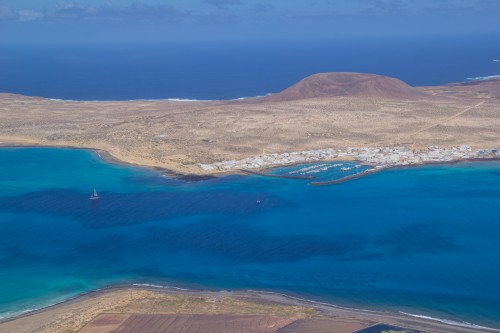 |
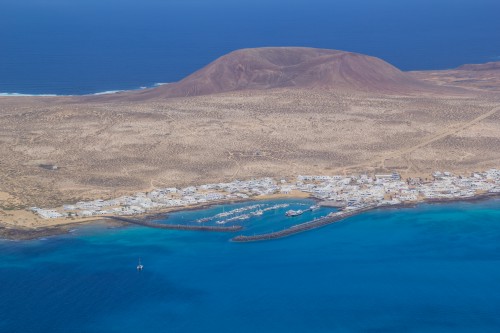 |
When we were close to Mirador del Rio, Eros asked if we wanted to go in and pay a fee, or just see the viewpoint from nearby. We decided to simply see the view. It was a gorgeous view, with a “river” of turquoise and dark blue, with some clouds above giving off shadows in the water. Across the river were all the white buildings on La Graciosa. Eros mentioned again that there was good, safe diving there since the water was not deep and there was very little water movement. Eros told us that he actually used to be (or perhaps still was?) a divemaster. He’d lived in Italy, and moved away after his networking company was acquired, first to Australia, then to Indonesia, and then a couple more places. When in Indonesia he’d done work as a divemaster, and had continued that. He said here on Lanzarote the majority of his clients were groups from Italy, and that because of that his English was getting a tad rusty since he didn’t use it that much.
 |
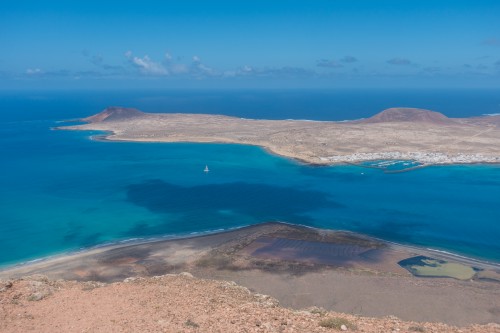 |
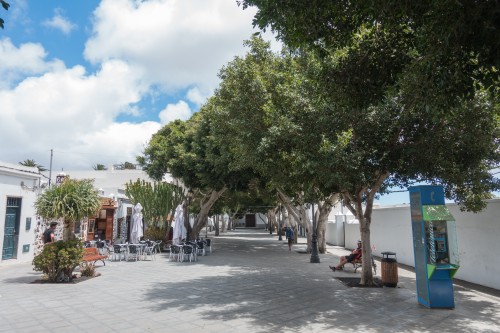 |
Our next stop was Haria, one of the only places on the island to have any green. The area is surrounded by 1000 palm trees (probably more than that now, actually). Pirates used to attack the area frequently, and killed a lot of people, especially the men. So the legend goes that the local people would plant one palm tree for every newborn girl and two for every newborn boy, and now the area is full of mature palm trees. In the small town Eros asked if we wanted lunch, and so we inquired as to what was left for the rest of the day. He said at the very least Timanfaya National Park (for volcanoes) and La Geria (for wine). We told him about the camel ride, and he said that’d be fine. So we thought we could kill two birds with one stone by eating at a winery later and skipping lunch now – again. So we just walked through one of the main squares in Haria, then got back in the car.
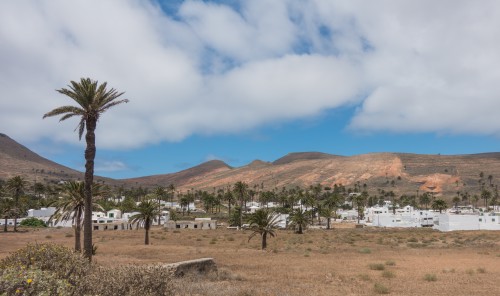 |
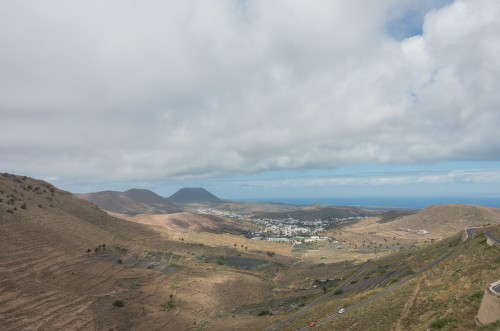 |
There was a windy road heading south from Haria, along a bunch of switchbacks – nice views abounded. We went through Teguise (another quaint village) and continued to head southwest through the La Geria wine region. The Lanzarote wineries are known more for whites than reds. The volcanic soils are good for the wine, and the cinder collects mist and humidity at night to keep the roots from drying out. We could smell the sulfur sprayed on the vines. One noteworthy thing about the grape vines in Lanzarote is that they are kept very low to avoid the wind, and they are famous for their semi-circular wind-breaks made from lava rock, to the point the area is a UNESCO site now. Lanzarote doesn’t have near the elevation of the other islands we’ve visited, so the wind just sweeps across the whole island and rarely drops any moisture.
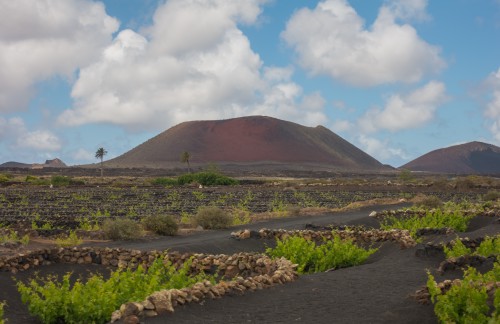 |
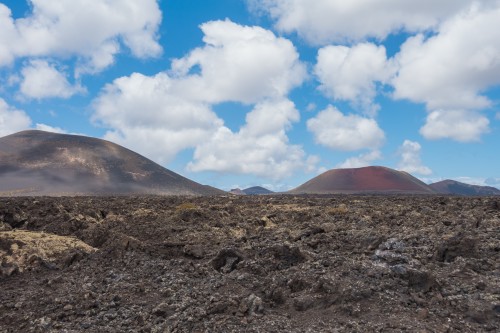 |
At Yaiza, we headed northwest into Timanfaya National Park. Yaiza looked a bit like Haria, with a nice square and narrow touristic streets. In Timanfaya, the mountains looked like Southwest Bolivia, with lots of red volcanic cones, and the ground looked like the saddle road on the Big Island. The scenery was definitely jaw dropping, much more desolate than the other islands we’d visited. Just inside park we stopped at the location for riding camels. For some unknown reason, we got moved around about 6 times before the people finally settled on which camel they wanted us to ride – we got Rosita.
 |
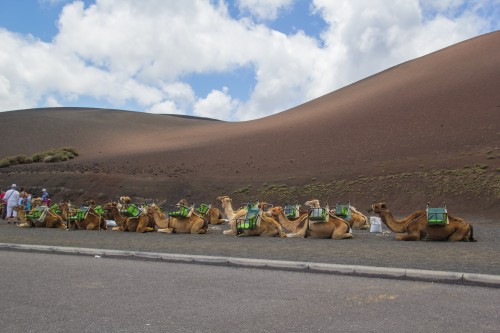 |
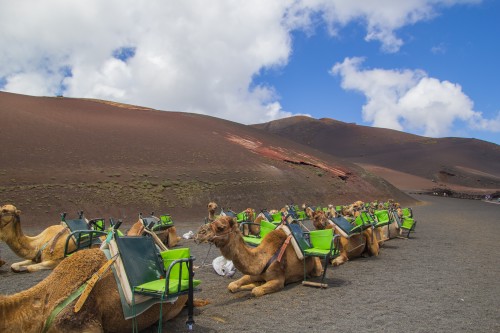 |
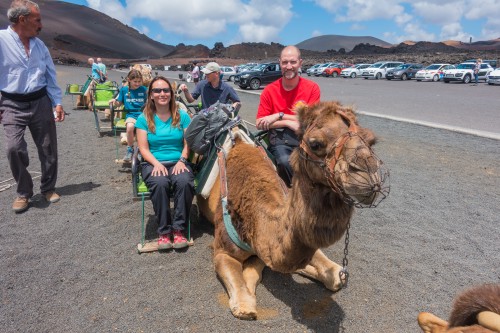 |
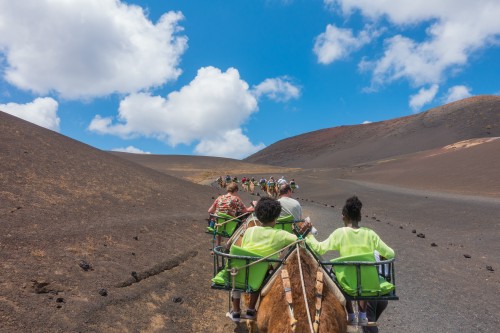 |
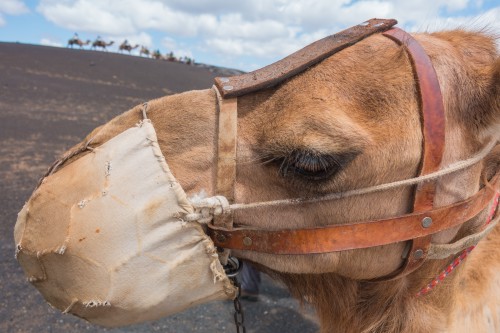 |
Rosita didn’t seem entirely happy with the set-up, and especially didn’t seem happy being behind the two camels in front of her. We think she wanted to be the lead camel. There were a handful of groups of camels, about 7-8 camels to a group. Our group was slow comparatively, perhaps because the lead camel wasn’t in much of a hurry. We walked uphill a bit, then circled around and came down. Rosita kept trying to walk on the side of the camel in front of us, and in the process kept freaking out the girls on the camel in front of us. We’ve now been blessed enough to have ridden camels on 3 continents – Africa (Egypt), Asia (Jordan), and Europe (Canary Islands). We should get Australia (Broome) one of these years, but aren’t sure about North and South America. We figure Antarctica is probably out.
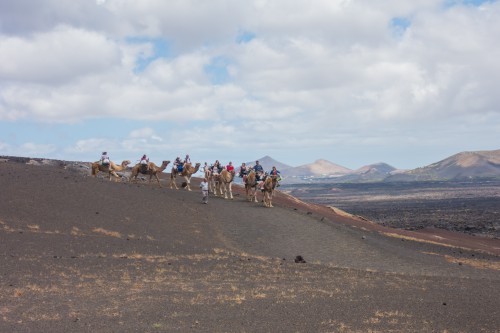 |
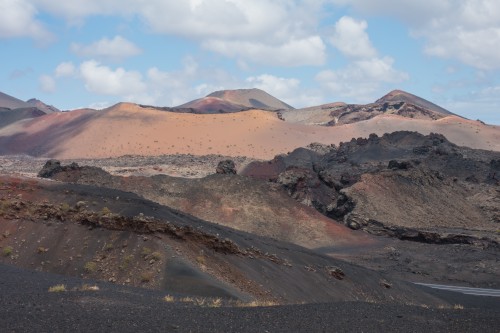 |
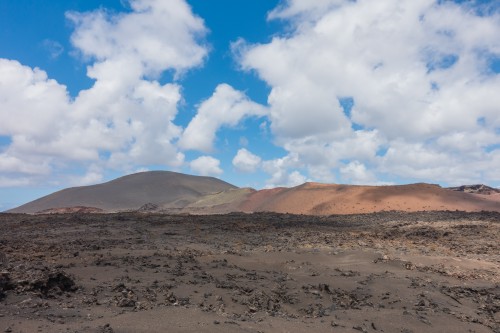 |
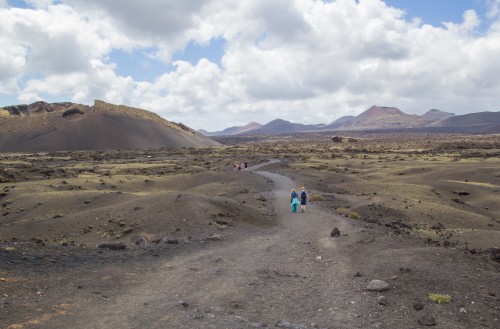 |
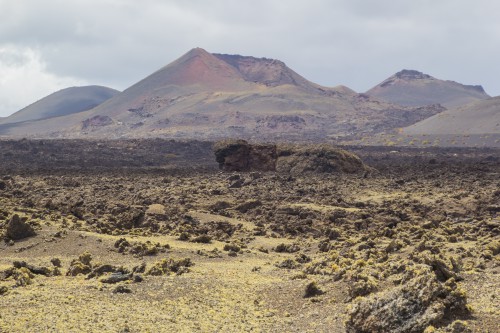 |
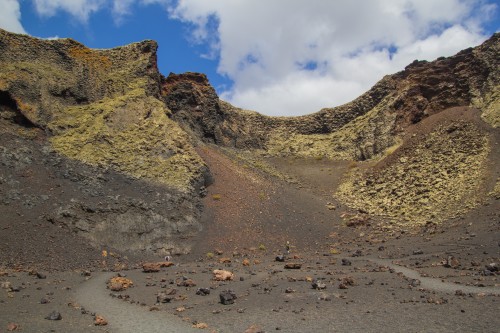 |
Timanfaya National Park doesn’t allow walking or private cars, only a bus that drives around (with no stopping, actually), so we decided to just drive through on the main road, then do a walk in the Natural Park, which is different from the National Park but has more or less the same scenery. There was lots of lichen on the rocks, but not much else besides the road, the lava, and the sky. The topography was very similar to Hawaii, but for here there is a layer of small rocks that makes everything look smooth – this is from explosive activity, which is far more common here than Hawaii. We walked up to a crater from a 1700s eruption, and passed by a giant chunk of rock expelled, just outside the crater. All around we saw evidence of the yellowish rock that results from water getting in and causing explosions. We’d heard a couple times what this is called, but can’t for the life of us remember. [We think it is phreatomagmatic]. Our walk was maybe 45 minutes or so, and it was nice to actually do some walking.
 |
After our lava walk we headed to a winery that Eros recommended, El Grifo. This is the oldest one on the island, and its design was made by Caesar Manrique. Once there, a woman showed us what they had, and interestingly we both picked the exact same 6 (out of the 9 or 10 they had available):
They brought out only one of each, maybe not realizing that we’d picked the same thing – this was probably for the best. We also got a plate that had two soft cheeses, one smoked and one not smoked, plus some crackers and nuts. We sat out on a covered patio and chatted with Eros for a bit. He told us he used to work on cruise ships – giant ones, with 17 levels, including 6 below water level. After his travels to Australia and Indonesia, he eventually made his way here, where he liked it so much he decided to stay, and he has been here for close to 6 years.
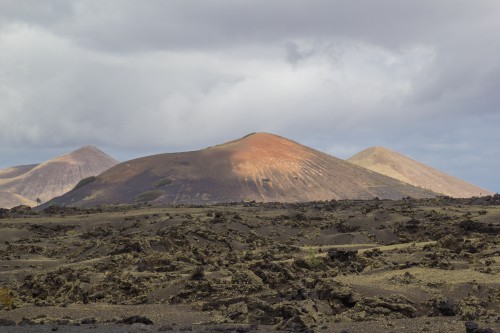 |
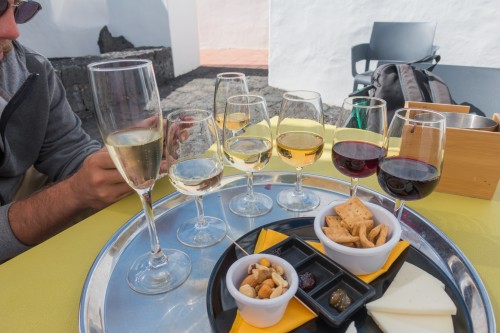 |
We asked him about our ordeal trying to arrange something for Fuerteventura, and he said he might actually be able to do this himself. He said it might be difficult logistically, however, because he’d need to take a ferry from Lanzarote to Fuerteventura, get a rental car, and have someone cover for him at his hotel job that he does on Thursdays. Unlike our other guides, we didn’t have the same immediate connection with him (possibly because of the mix-up trying to find one another, possibly because some of the sites were really crowded, possibly because we woke up on the wrong side of the bed, who knows), but over the day we warmed up. We really hoped we’d be able to see him again tomorrow.
After finishing our cheese and wine we headed back towards Arrecife. Along the way he casually dropped a fascinating tidbit – we just so happened to be visiting Lanzarote on an important day, “Cesar Manrique was 100 years old today.” We’re surprised we hadn’t heard that or seen that anywhere else. Maybe that’s what the private event at Jameos del Agua was all about, who knows. We got back to the ship a little after 6, and told Eros we hoped to see him tomorrow, but understood if it would not be possible. He said he’d text us as soon as he figured out whether he’d be able to make things work. Back on the ship we went straight to the office area on 7 and asked one of the employees about what tours were available if we couldn’t make anything work in terms of private tours. To his credit, he didn’t try to sell us anything, indicating that with what we were interested in, a chartered taxi might work best. So we decided to give that a go if we didn’t hear back from the litany of folks we’d contacted in the last week.
Back in the room we got a bit of good news – there was a voicemail stating that they’d received our suggestion form, and that now the Patio Bar and Matias would have their own Pisco. On the flipside, we got an email from Ignacio at Cantour, stating that despite his best efforts, he wasn’t able to set anything up for Fuerteventura. Shortly after that we got a text from a person Guillermo recommended for Fuerteventura – he was not available himself, but he had a friend who would contact us, Jane. We got changed and went up to the Patio Bar and enjoyed some Pisco with Matias. Whilst sitting at the bar, Jane contacted us, telling us she could do a tour (success, finally!), but that she could not arrange transportation, so we’d have to figure that out. So over our Pisco Sours we discussed this and figured that if we were going to have to charter a taxi anyway, we might as well do that without a guide, since the sites we were most interested in were things like dunes, hikes, and lookouts that we wouldn’t really need a guide for.
At dinner (in addition to the Yellowfin tuna and Black cod for Crystal, and cavatappi pasta and rotisserie chicken for Justin) we had some interesting conversations. We were debating how exactly a ship floats, and we knew it had something to do with displacement, but couldn’t remember the exact process. On a whim we asked Frederico, the manager of Earth & Ocean. It turns out that Frederico has a physics degree, knew it was called Archimedes Principle, and then explained to us in detail how it worked. Between his physics degree, Crystal’s chemistry degree, and Justin’s engineering degree, we had three people enjoying their life on a cruise ship. [FYI, according to Wikipedia, Archimedes Principle states that the upward buoyant force that is exerted on a body immersed in a fluid, whether fully or partially submerged, is equal to the weight of the fluid that the body displaces and acts in the upward direction at the center of mass of the displaced fluid.]
After our science discussion with Frederico we had a political (sort of) discussion with Jose about the drug trade and how it impacted Peru. The main take away we had is that we don’t ever want to end up in a Peruvian prison. After dinner we headed up to the Observation Bar, and apparently we had talked so long at dinner that we missed the loud British guy from the night before. Instead we had a nice chat with the German Australians and Helder. We stayed until about 11:15, then went downstairs to get some sleep.
| Previous Day |